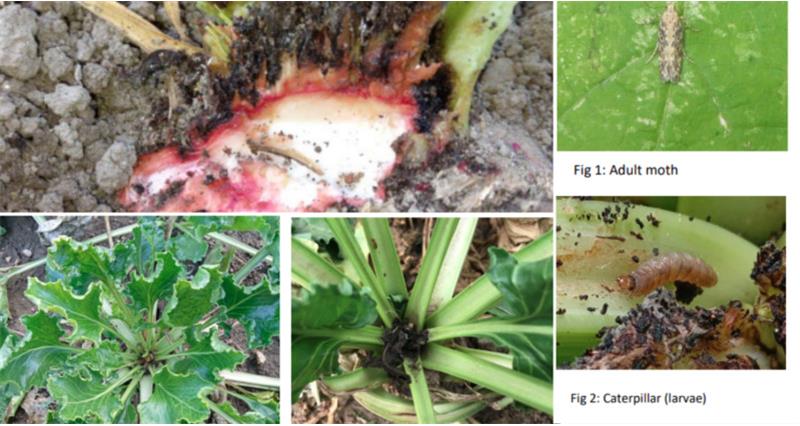The beet moth (Scrobipalpa ocellatella) is not recorded as a regular pest in the UK, but adult moths are trapped and reported in the UK by entomologists. It is known to be more problematic in Mediterranean areas where its incidence and reports of damage are usually associated with warmer and drier climates.
There's limited information on the life cycle of beet moths in UK sugar beet crops, but it's likely that adults can won't die over winter and can migrate into crops in the spring. They breed by depositing eggs into the crown of the crops. Caterpillars (larvae) will then hatch and feed on the leaves and crown. These will develop into adults and produce further generations.
Symptoms
The symptoms begin as the caterpillars start to eat and develop within the centre heart leaves of the beet plant. It is easy to confuse symptoms with boron deficiency or downy mildew, but on closer inspection the caterpillars (in various colours) can be found within the damaged area of the heart leaves.
Symptoms include:
- Blackening of the crown.
- The loss of some new leaves.
- In more severe cases, the affected crown may be killed and lateral growing points stimulated to produce leaves, resulting in multi-crowning.
- In some cases, all growing points may be affected.
- The presence of adult moths amongst the canopy.
The extent of the damage will depend on the number of caterpillars and, in many cases, plants will continue to produce new leaves.
Risk Factors
Continued warm, dry autumn conditions will benefit the spread and development of the moth into early October.
If the tap root is damaged, this could result in infection by secondary pathogens and further deterioration of the tap root leading to localised rotting. The plant may recover from the damage to the heart leaves by forming multiple crowns around the damaged centre. However, there is also the risk that a hollow crown results from the damage, and that could lead to further tap root damage from water settling or from frost later in the winter.
Prevention
A wet, unsettled, and cool autumn will help to hinder the development of the pest. Cool, wet weather usually deters beet moth development, and heavy rain events and/or irrigation usually drowns the caterpillars.
Insecticides
Ploughing down beet remnants that have been impacted by beet moth may well help to decrease the risk for 2023. There is the potential for a foliar applied insecticide to be used but this will require large water volumes to penetrate the canopy. Therefore, results may well be variable as it is the caterpillar within the heart leaves that the insecticide needs to target.
Experiences with pyrethroids in the UK to date are variable and limited; this re-enforces comments from Europe too. Use of pyrethroids will also impact any beneficial insects.
There are a few products such as Cythrin that have general caterpillar control on their label. It is important that you follow the recommendations on the label. In many cases, this includes the use of high-water volumes.
Disease Control
It is important to keep all remaining and future leaves as green and healthy as possible for as long as possible to mitigate the impact of beet moth damage. Ensure disease control is as robust as it can be and consider the use of Mn & Mg to support canopy recovery.
Check your crops, especially in the Bury factory area, monitor symptoms and review against planned harvest date. Limited or late damage on early lifted crops will have little risk or impact on yield.
More serious damage or later lifted crops will become increasingly at risk of yield and quality damage, suggesting earlier harvesting than planned could be advisable.
Keep an eye on the latest BBRO guidance for the most recent updates and information.
